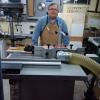A kilopascal is a measurement of pressure, similar to psi. It's a commonly used metric term, but for the mechanically minded it is not clear, like grams per square centimeter would be. Atmospheres (bar) is useful also. For a rocket scientist, kilopascal is more convenient when working in places other than the surface of the earth or to high precision. For me a useful number is that a psi equals about 7 kilopascals. I like the metric system, just not this particular convention.







 Reply With Quote
Reply With Quote

 That's the only Newton most Yanks are going to be familiar with. I get along reasonably well with many metric measures but Newton just doesn't compute for me. Aircraft engine output is often expressed as pounds of thrust or KiloNewtons. There are of course online converters but that's one unit of measure I have trouble getting my head around.
That's the only Newton most Yanks are going to be familiar with. I get along reasonably well with many metric measures but Newton just doesn't compute for me. Aircraft engine output is often expressed as pounds of thrust or KiloNewtons. There are of course online converters but that's one unit of measure I have trouble getting my head around.





